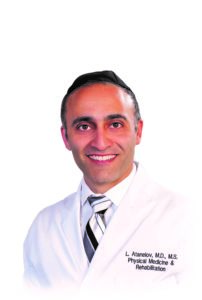QUESTION: What is a fall prevention doctor and how is this professional different from other care?
ANSWER: A fall prevention doctor is a physician with knowledge and experience to diagnose and treat conditions that cause balance deficits and risk of falls. No one medical specialty encompasses everything necessary to achieve this goal.
During my early years at Johns Hopkins, I began realizing the meaning behind the concept of a fall prevention physician. Later, I left to develop the nation’s first comprehensive fall prevention medical institute. We bridge diverse medical specialties to comprehensively analyze each patient’s bio-psychosocial situation (for example, medical conditions, living environment, ability to drive and social supports) through the lens of human biomechanics (how the body moves) and generate a tailor-made patient-centered intervention.
QUESTION: What can I expect from a consultation?
ANSWER: You’ll feel a clear sense of before and after by improving your safety and independence in your daily life activities and mobility.
There will be a physical examination. At the end of the first visit, you’ll understand how your medical condition(s) increase your fall risk. You’ll be given a home exercise program and detailed goal-oriented physical or occupational therapy prescription. We will communicate with your usual medical providers. Your response to interventions will be closely monitored and interventions will be fine-tuned to help you graduate in six to eight weeks. Insurance covers these interventions, with no surprise bills.
QUESTION: Does this multidisciplinary approach work?
ANSWER: Most physicians and patients aren’t aware that the
CDC doesn’t advise using physical therapy alone to prevent falls; rather a multidisciplinary approach is recommended. It explains why many patients say they did not get significant, lasting results despite months, or years, of physical therapy they previously had. We employ unique multimodal diagnosis and treatment. Nine out of 10 of our patients report at least 50% improvement. We’re currently in the process of validating these remarkable results and submitting them for publication.
QUESTION: Isn’t falling normal?
ANSWER: Falling is common with age, but it is not normal. We differentiate between acute triggers of falls (such as tripping over sidewalk curbs or infection) and chronic underlying age-related medical conditions (for example, arthritis, neuropathy, and Parkinson’s disease) that increase odds of falling. Many impairments can be remediated, at least partially. The CDC recommends that older adults remove tripping barriers, have regular eye and foot exams, and review medications with their internist. These interventions alone are too general. Successful identification and treatment requires a focused patient-specific assessment and plan.
QUESTION: I didn’t fall, or I only fell twice. Do I still need fall prevention?
ANSWER: If you have experienced one fall with trauma or two falls without trauma in a 12-month period, please contact me. We know that heart attacks and strokes can kill, but unfortunately falls can also kill or significantly limit one’s independence and positive life experience. One in five falls causes major trauma or death. Falls are the leading cause of hip fractures in the elderly. It is very important to do what you can to prevent falls and ask for support when needed. If you are concerned for yourself or a loved one, please connect with me.
Steady Strides
9199 Reisterstown Rd.
Suite 101B
Owings Mills, MD 21117
Phone: 443 898 8160
Email: [email protected]
Website: www.steadystridesmd.com










